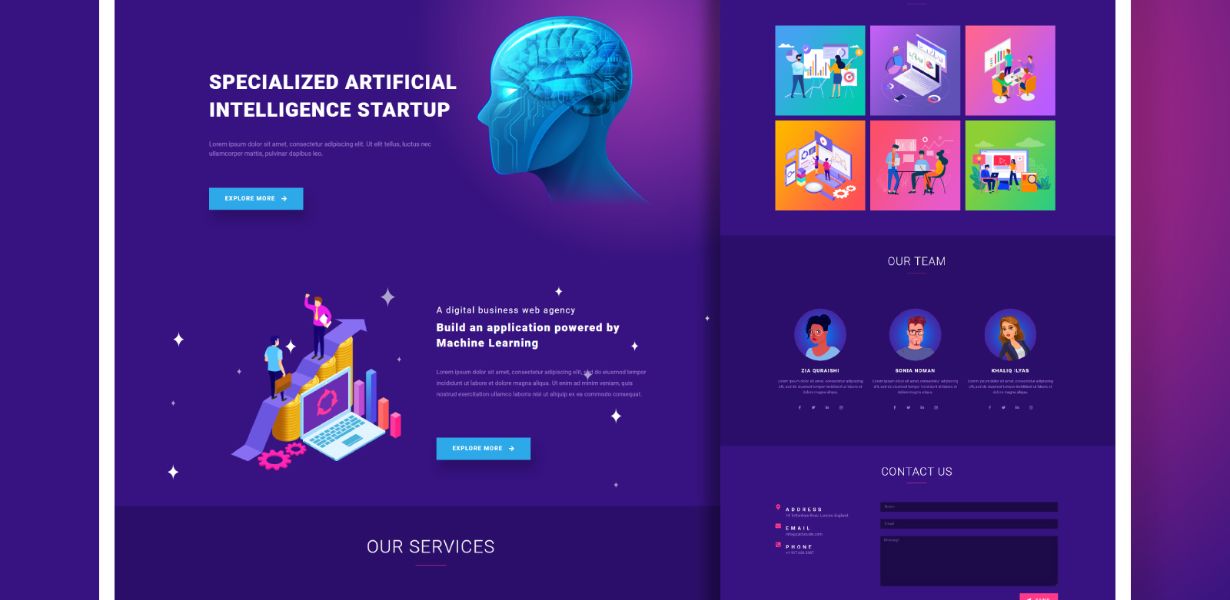
Artificial Intelligence for Dynamic Image Resizing: Next-Gen Solutions for Responsive Web Design
- Post
- August 7, 2023
- Mobile & Responsive, Responsive Images, Web Design
- 0 Comments
In today’s digital era, where mobile devices and various screen sizes dominate the online landscape, creating a visually appealing and user-friendly website is paramount. Responsive web design has become a necessity to adapt to these diverse devices and screen resolutions. One of the crucial aspects of responsive design is dynamic image resizing. In this blog, we explore cutting-edge solutions empowered by Artificial Intelligence (AI) that enable responsive background images and responsive images in HTML, revolutionizing the way we design websites.
Understanding Responsive Web Design
Responsive web design is an approach that allows web pages to adapt and display seamlessly on different devices, including desktops, tablets, and smartphones. It ensures that the website’s layout, content, and images adjust dynamically to fit various screen sizes, eliminating the need for separate mobile versions. While responsive design has become a standard practice, the challenge lies in managing images efficiently.
The Challenge: Responsive Images
Traditional approaches to responsive images involve using HTML and CSS to resize them based on the screen width. However, this approach often leads to loading large images on small devices, causing slower page loading times and increased bandwidth usage. This is where Artificial Intelligence steps in to offer dynamic and intelligent image resizing.
AI-Powered Image Resizing Solutions
Smart Image Compression
AI algorithms can analyze images and determine the optimal compression level without compromising quality. By reducing image size while maintaining visual integrity, web pages load faster, leading to improved user experience and search engine rankings.
Content-Aware Image Cropping
AI-driven content-aware image cropping automatically identifies the essential parts of an image and removes unnecessary elements during resizing. This ensures that crucial elements remain visible on all devices, providing consistency and visual appeal.
Device-Specific Image Loading
Using AI, websites can detect users’ devices and screen sizes and serve the most appropriate image resolution. This personalized approach reduces page load times and enhances overall performance.
Lazy Loading with AI
AI can predict users’ scrolling behavior and load images only when they are about to come into view. This technique, known as lazy loading, further reduces initial page loading times, benefiting both users and search engine rankings.
AI-Powered Art Direction
Art direction through AI involves selecting and displaying the most relevant image cropping and layout based on the user’s context. This level of personalization provides a tailored user experience and encourages higher user engagement.
Image Format Optimization
AI algorithms can analyze images and recommend the most suitable format (JPEG, PNG, WebP, etc.) based on their content and complexity. This optimization reduces file size without compromising image quality.
Aspect Ratio Preservation
AI helps maintain the aspect ratio of images during dynamic resizing, ensuring that images don’t appear distorted on different devices.
Responsive Background Images
With AI-powered responsive background images, web designers can create visually stunning and adaptive backgrounds that adjust seamlessly to different screen sizes and resolutions.
AI-Generated Alt Text
Artificial Intelligence can generate descriptive alternative text (alt text) for images, making web content more accessible to users with visual impairments while enhancing SEO.
Performance Monitoring and Optimization
AI can continuously monitor website performance and suggest optimization strategies, ensuring that the site remains responsive and user-friendly.
Final Words
Embracing Artificial Intelligence for dynamic image resizing is an indispensable step towards achieving responsive web design excellence. By leveraging AI-powered solutions, web designers can ensure optimal user experience, faster load times, and improved SEO rankings. Stay ahead in the ever-evolving digital landscape by integrating cutting-edge AI technologies into your web development process. Explore the realm of AI-driven image resizing and witness a transformation in your website’s responsiveness and user engagement.
Commonly Asked Questions
Q1: How does AI-powered image resizing benefit SEO efforts?
A1: AI-powered image resizing significantly improves page load times, which is a crucial SEO ranking factor. Faster-loading pages lead to better user experience and higher search engine rankings.
Q2: Can AI help in optimizing images for different social media platforms?
A2: Absolutely! AI algorithms can tailor image sizes and formats based on the requirements of various social media platforms, ensuring that your content looks perfect on each platform.
Q3: Is AI image resizing suitable for all types of websites?
A3: Yes, AI image resizing is versatile and suitable for various websites, from small blogs to large e-commerce platforms. It enhances user experience across all types of web pages.
Q4: Will AI-generated alt text be as accurate as manually written descriptions?
A4: AI-generated alt text is continually improving and can produce accurate descriptions in most cases. However, manual review and adjustments are recommended to ensure complete accuracy.
Q5: How can AI enhance the personalization of image display?
A5: AI analyzes user behavior and context to determine the most suitable image layout and cropping, providing a personalized and engaging experience for each user.




